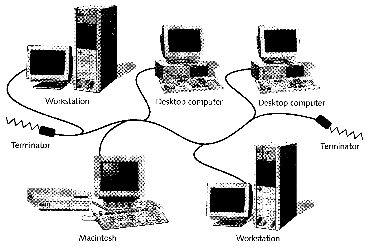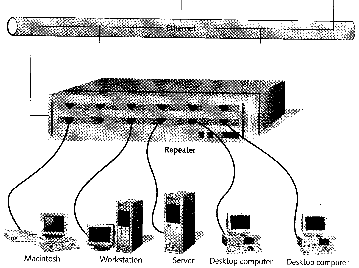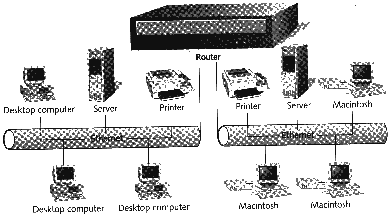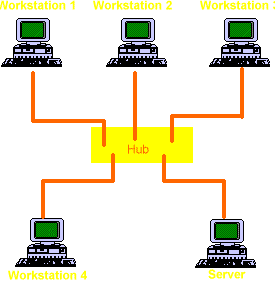 Diagram
of a Bus Topology
Diagram
of a Bus TopologyCourse:
Networking Technologies
CIS 63
Folsom Lake Center
Spring, 1999
Jamie Willson
Project by:
Marc Hall
Bob Shimizu
Melanie E. Biner
Mike Datko
Elaine Lyman
Physical Topology
IEEE standard 802.3, also referred to as Ethernet, is the most commonly used networking technology in the world today. Used primarily in local area networking, ethernet was developed in the 1970s at Xerox in Palo Alto, CA by Dr. Robert Metcalfe. In 1980, a team of computer scientists from DEC (Digital Equipment Company), IBM and Xerox put together a protocol known as DIX-Ethernet. In 1985, the IEEE (Institute for Electrical and Electronics Engineers) standardized protocols for Ethernet into what is known today is IEEE standard 802.3.
 Diagram
of a Bus Topology
Diagram
of a Bus TopologyThe physical topology of a network (cabling layout) can differ from the logical topology, which describes how the electronic signal is routed over the cables. The traditional physical topology of an Ethernet network is a linear bus, consisting of a single coaxial cable with a terminating resistor at both ends. 10 base5 Ethernet is also known as thicknet, while 10base2 Ethernet is known as thin net. Nodes in the network are attached to the coaxial cable via T-connectors (10base2) or "vampire" taps (10base5). The terminators are 50-ohm resistors and are the same for both thicknet and thinnet. The bus topology is relatively easy to implement and the initial installation cost is low. It has the disadvantage of being relatively difficult to troubleshoot in comparison to ring and star networks.
A newer technology known as 10baseT, using UTP or STP cable, is now one of the most commonly installed version of Ethernet. 10baseT use a physical star topology; nodes are connected to a central hub in a star-like array. The star topology has an advantage over the bus topology in that it is easy to troubleshoot network problems. Configuration is relatively easy.
 Diagram
of a Repeater on a Network
Diagram
of a Repeater on a NetworkRepeaters are network devices that are capable of amplifying an attenuated signal as it travels down the network to a distant node. Current limitations on segment length are 500m for 10base5, 185m for 10base2 and 100m for 10baseT. Repeaters allow distant nodes on the network to overcome these limitations. Some repeaters are just amplifiers while others are capable of cleaning up external noise, transmitting an amplified "clean" signal to distant nodes on the wire. Ethernet (coax) networks are subject to the 5-4-3 rule, which states that a maximum of five segments can be connected to each other using four repeaters. Of these five segments, only 3 can be occupied by network nodes. 10baseT applications follow the 5-4 rule, which states that a maximum of 5 segments can be connected to each other by no more that 4 hubs.
 Diagram
of a Bridge Connecting Network Segments
Diagram
of a Bridge Connecting Network SegmentsBridges and switches are devices that increase throughput of a Local Area Network. The succeed in this task by the following methods:
 Diagram
of a Router Connecting Networks
Diagram
of a Router Connecting NetworksRouters are used to connect networks with dissimilar data-link layers. Routers work primarily at the Network Layer of the OSI Seven Layer Model; operating at this layer is more labor intensive than devices operating at the Data Link layer, such as bridges and switches. This results in slower processing capabilities as compared to bridges and switches but the ability to use and interpret more information. Local routers can also be used to segment packet traffic on a congested network. Routers used as "firewalls" can secure a network from outside traffic.
 Diagram
of a Hub Connecting Network Segments
Diagram
of a Hub Connecting Network SegmentsHubs are the backbone of the 10baseT ethernet network. These devices allow large numbers of computers to be connected on a single or multiple LAN. Hubs operate at the Physical Layer of the OSI Seven Layer Model. They are not considered "smart" devices and do not make use of any source and destination address data.
Pick your subject:
Page Updated May 6, 1999
Content by Bob Shimizu
Design by Marc Elliot Hall